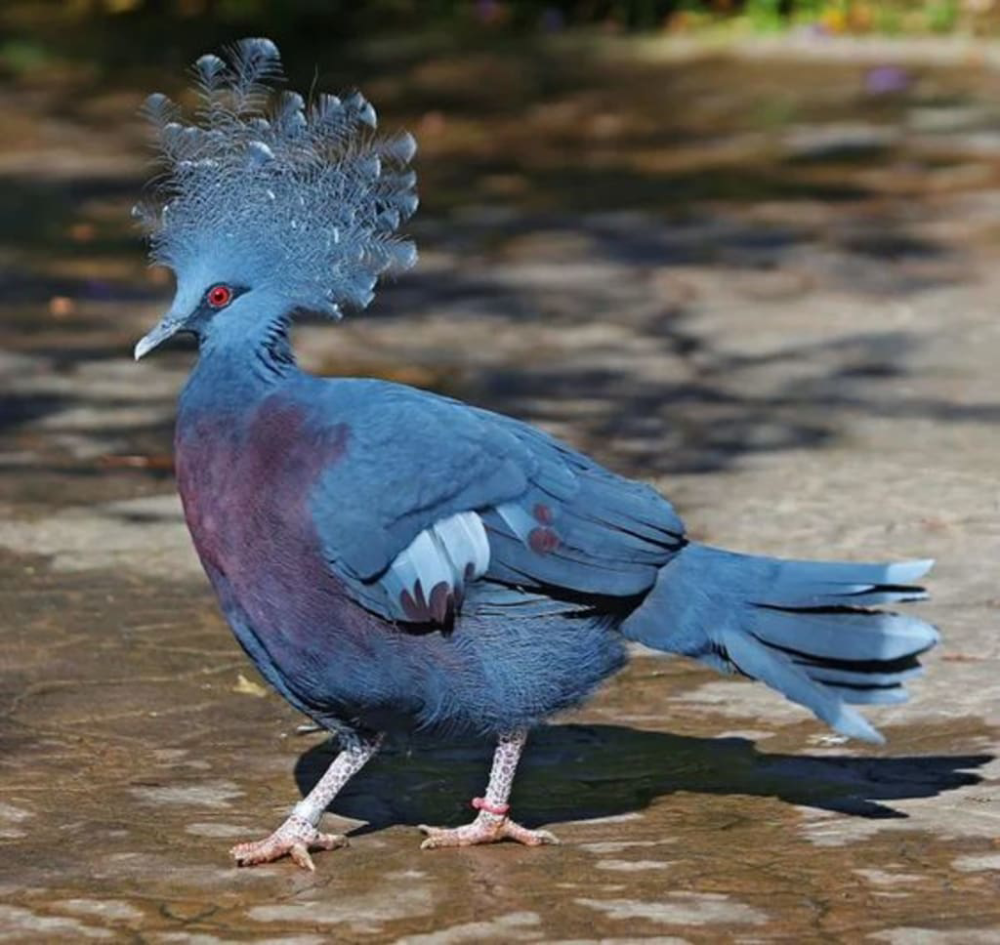The Victoria crowned pigeon (Goura victoria) is a remarkable bird that stands out not only for its size but also for its stunning appearance and unique behaviors. Named after the British monarch Queen Victoria, this pigeon is one of the most spectacular and largest members of the pigeon family, Columbidae. Native to the lowland and swamp forests of northern New Guinea and surrounding islands, the Victoria crowned pigeon is a symbol of avian grandeur and a testament to the diversity of life in the region.
Physical Characteristics
One of the most distinctive features of the Victoria crowned pigeon is its striking crest of lacy feathers, which gives it a regal appearance. This crest has white-tipped feathers that form an intricate fan-like shape, resembling a delicate crown. The body of the pigeon has a vibrant blue-gray plumage, while its wings are a striking combination of maroon and lighter blue. The eyes are a piercing red, adding to the bird’s intense and captivating look.
The Victoria crowned pigeon is a large bird, measuring up to 74 centimeters (29 inches) in length and weighing between 2.3 to 3.5 kilograms (5 to 7.7 pounds). Its robust body and powerful legs make it well-suited for life on the forest floor, where it spends much of its time foraging for food.

Habitat and Distribution
The natural habitat of the Victoria crowned pigeon includes the lowland rainforests, mangrove forests, and swampy areas of northern New Guinea and surrounding islands. These birds prefer dense, undisturbed forests where they can find ample food and shelter. Their habitat has high humidity and thick vegetation, providing an ideal environment for their nesting and foraging activities.
Due to habitat destruction and hunting, the distribution of Victoria crowned pigeons has become fragmented, and their populations are now primarily confined to protected areas and remote regions where human encroachment is minimal.
Behavior and Diet
Victoria crowned pigeons are primarily ground-dwelling birds. They exhibit a calm and deliberate demeanor as they walk gracefully through the forest floor in search of food. Their diet mainly consists of fallen fruits, seeds, and also small invertebrates. They have a particular preference for figs, which are abundant in their natural habitat.
These pigeons are social birds, often found in small groups or pairs. During the breeding season, they engage in elaborate courtship displays. The male performs a series of bowing motions, accompanied by soft cooing calls, to attract a mate. Once paired, the birds are monogamous and work together to build a nest, typically in the lower branches of a tree or shrub. The nest consists of twigs and leaves, and the female usually lays a single white egg.
Both parents share the responsibility of incubating the egg and caring for the chick. The young pigeon, popular as a squab, eats rich, nutritious substance called “pigeon milk,” from both parents. This high-protein, high-fat secretion is crucial for the rapid growth and development of the chick.
Conservation Status
The Victoria crowned pigeon is classified as Near Threatened on the International Union for Conservation of Nature (IUCN) Red List. The primary threats to its survival include habitat destruction due to logging, agriculture, and human settlement, as well as hunting for its striking plumage and meat. Conservation efforts are focused on protecting its natural habitat and enforcing hunting regulations to prevent further decline of the population.
Several conservation programs and breeding initiatives exist in zoos and wildlife reserves around the world to help preserve this magnificent species. These programs aim to raise awareness about the importance of biodiversity and also the need to protect endangered species like the Victoria crowned pigeon.
Cultural Significance
In addition to its ecological importance, the Victoria crowned pigeon holds cultural significance for the indigenous peoples of New Guinea. It is often featured in traditional stories, dances, and art, symbolizing beauty, grace, and the rich natural heritage of the region.
The bird’s name itself is a nod to colonial history, people named it in honor of Queen Victoria. This connection to historical figures adds another layer of interest and intrigue to the bird’s already fascinating profile.
Conclusion
The Victoria crowned pigeon is a true marvel of the avian world, with its exquisite appearance, unique behaviors, and significant cultural and ecological roles. Protecting this species and its habitat is essential for maintaining the biodiversity and ecological balance of the rainforests of New Guinea. So, by raising awareness and supporting conservation efforts, we can ensure that future generations will continue to marvel at the beauty and majesty of the Victoria crowned pigeon.









